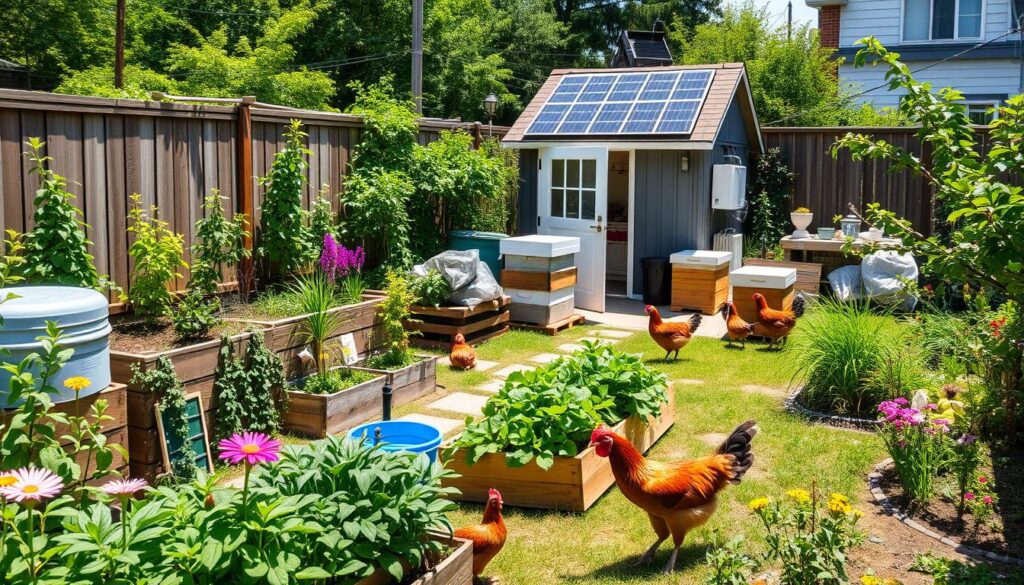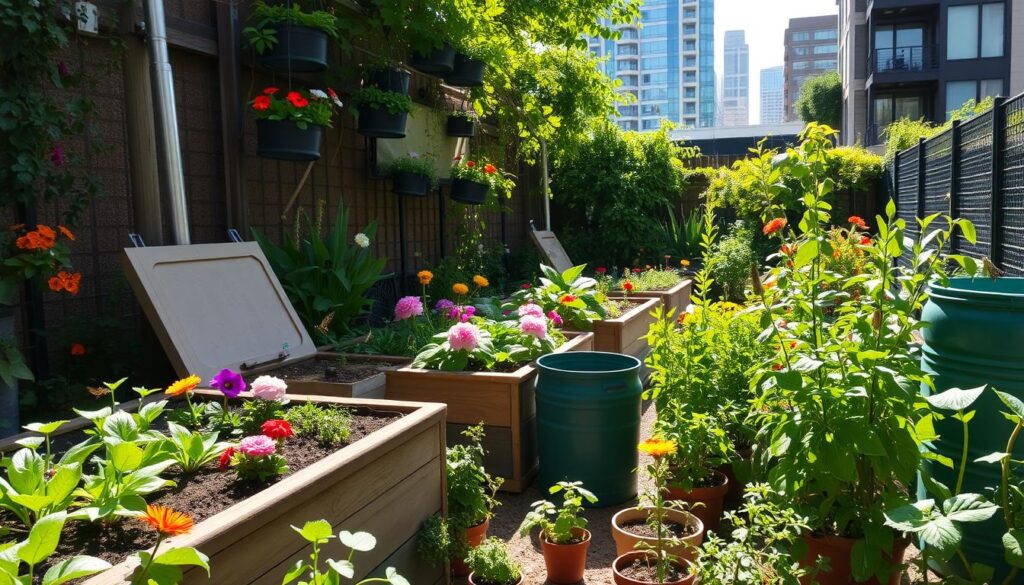Self Sufficient Backyard Review: Ultimate Guide for 2024
Creating a self-sufficient backyard is a smart move. It helps you use less from outside and live greener. Many are now making their backyards self-sufficient. This means having fresh food, clean water, and green energy right at home.
By doing this, you can cut down on bills and help the planet. It’s a win-win for your wallet and the Earth.
This guide will show you how to make your backyard self-sufficient. You’ll learn about urban gardening, living green, and using renewable energy. With 7,000 words of tips, you’ll be ready to start.
Whether you want to grow food, collect rainwater, or make electricity, we’ve got you covered. This guide will give you the tools to make your backyard self-sufficient.
Key Takeaways
Table of Contents
- Creating a self-sufficient backyard can help you save money on food, energy, and water bills
- Urban gardening and sustainable living practices can reduce your carbon footprint
- Rainwater harvesting and drip irrigation systems can conserve water
- Solar panels and small wind turbines can provide renewable energy
- Composting and incorporating native plants can reduce waste and fertilizer use
- A self-sufficient backyard can provide you with fresh produce, clean water, and renewable energy
- Initial investments in a self-sufficient backyard can lead to long-term savings
Understanding the Self Sufficient Backyard Program
Starting your journey to a self-sufficient backyard is exciting. The program focuses on homesteading, permaculture, and off-grid living. It helps you move from needing utilities to being completely self-sufficient. Jonas Reynolds says “The Self-Sufficient Backyard” shows you how to do this.
The program has 12 chapters. Each chapter covers a different self-sufficiency topic. You’ll learn about gardening, animal care, renewable energy, and natural remedies. You’ll also discover how to make a cheap water collection system and use solar, wind, and water power.
Core Program Components
- Gardening and food production
- Animal care and management
- Renewable energy and natural remedies
- Food preservation and home security
Author Background and Expertise
Ron and Johanna Melchiore have over 40 years of off the grid living experience. Their knowledge in sustainable systems is invaluable for those wanting a self-sufficient lifestyle.
Program Format and Accessibility
The program is available in physical and digital formats. It comes with a 60-day money-back guarantee. The physical bundle is $47, and the digital is $37. With over 200 pages of expert advice, you can start your self-sufficient backyard in 100 to 200 square feet.
Key Features and Benefits for Homesteaders
Starting a self-sufficient backyard brings many benefits. You’ll have food security, lower environmental impact, and save money. This lifestyle boosts your self-reliance and helps the planet.
A self-sufficient backyard includes growing food, managing water, and making energy. These parts make a sustainable space. With over 75 projects, you can make your backyard farm thrive.
Here are some benefits of a self-sufficient backyard:
- Lower utility bills with energy-saving steps
- More food from backyard farming
- More self-reliance and freedom
- Helping the planet with an eco-friendly lifestyle
By adding these features, you’ll make a backyard that meets your needs. It will also help make the future greener.
| Feature | Benefit |
|---|---|
| Food production | Increased food security |
| Water management | Reduced water costs |
| Energy generation | Reduced utility bills |
Essential Planning Tools and Resources
To make a self-sufficient backyard, you must plan well. This means designing your garden, picking what to grow, and managing resources. This way, you can enjoy grow your own food and urban gardening, and live sustainably.
A good garden plan can cut your grocery bills by 30-50%. Use garden planning blueprints to see your space and use it well.
Garden Planning Blueprints
These blueprints help you choose what to grow and where. They also guide on how to care for your plants. Use seasonal growing guides to grow food all year round.
Seasonal Growing Guides
These guides tell you what crops to plant in each season. They help you use your garden best. Also, resource management tools help you track water, energy, and waste. This makes your garden productive and green.
With these tools, you can have a thriving backyard. It will give you fresh food, lower your environmental impact, and save money. Always think about urban gardening and sustainable living when planning. Try new things like vertical gardening to use space better.
| Resource | Benefits |
|---|---|
| Garden Planning Blueprints | Helps visualize garden space, maximizes yield |
| Seasonal Growing Guides | Provides information on what crops to plant during each season |
| Resource Management Tools | Helps monitor and manage water, energy, and waste |
Implementing Your Sustainable Backyard System
Starting small is key when you begin your sustainable backyard system. This way, you can learn and grow with your projects. Off-grid living and backyard farming need planning, but you can face challenges head-on.
Being open to learning is vital for self-reliance. Every backyard is different. This flexibility helps you create a system that suits you perfectly. Benefits include less reliance on public services, growing your own food, and saving rainwater.
Here are some tips to get you started:
- Start with a small garden or a rainwater collection system
- Be open to learning and adapting to new situations
- Focus on backyard farming and off-grid living techniques
- Embrace self-reliance and take control of your sustainable backyard system
Follow these tips and stay committed to your sustainable backyard system. Enjoy the perks of off-grid living and backyard farming. Always remember to be open to learning and adapting.

Here is a summary of the benefits of implementing your sustainable backyard system:
| Benefits | Description |
|---|---|
| Reduced utility bills | By collecting rainwater and using solar energy, you can reduce your reliance on public utilities |
| Increased food production | By growing your own food, you can enjoy fresh, healthy produce and reduce your reliance on store-bought food |
| Improved self-reliance | By embracing self-reliance, you can take control of your sustainable backyard system and enjoy the many benefits of off-grid living |
Complete Self Sufficient Backyard Review and Analysis
Thinking about a self-sufficient backyard? It’s key to look at what’s out there. The self-sufficient backyard program is a full guide for urban gardening and homesteading. It helps you live a sustainable life.
Ron and Johanna, with 40 years of off-grid living, made this program. It’s easy for beginners to start homesteading. You’ll learn about chicken coops, greenhouses, water collection, and more.
The program gives great tips on raising chickens and saving seeds. It even has digital bonuses like guides on aquaponics and DIY projects. You’ll also find resources for free land in the US.
The program is worth the money, with lots of useful info. You can get a refund if you’re not happy. It works for any land size and helps you save money.
| Program Features | Description |
|---|---|
| Comprehensive approach | Covers various self-sufficiency topics, including chicken coops, greenhouses, and medicinal gardens |
| Practical advice | Provides guidance on maximizing egg production and seed preservation techniques |
| Digital bonuses | Includes guides on aquaponics, DIY projects, and resources for finding free land in the US |
Real-World Success Stories and Results
Starting your journey to a self-sufficient backyard is exciting. Seeing others succeed can inspire you. Many people have made their backyards green and productive. They grow their own food and live more sustainably.
Some have turned small backyards into homesteads. They have gardens, animals, and green energy. Urban gardeners grow food, and rural homesteaders live big and green.
Being self-sufficient brings many benefits. You get more food security, use less commercial food, and help the planet.
- Enhanced food security
- Reduced reliance on commercial food systems
- Improved environmental sustainability
These wins show how good sustainable living is. Growing your own food and living green can make you part of this success.
With the right help, you can make your backyard a green oasis. It’s good for the planet and you. Start your journey today and join the green living community.
“By growing our own food and implementing sustainable living practices, we can create a better future for ourselves and for generations to come.”
Sustainable Living Integration Strategies
Starting your journey to self-reliance means living sustainably. This means using less energy, managing water better, and reducing waste. These steps help make your backyard a green space for off-grid living and farming.
Using solar panels can cut down your energy bills. Rainwater harvesting and drip irrigation save water for farming. These actions boost your self-reliance and cut down on public utility use.
Energy Conservation Methods
Conserving energy is key to living sustainably. Using less power by turning off things you don’t need helps the planet and saves money. It’s a win-win.
Water Management Systems
Managing water well is vital. Collecting and using water wisely cuts down on public water use. Rainwater harvesting and smart irrigation systems help a lot.
Waste Reduction Techniques
Reducing waste is important for a green backyard. Composting, recycling, and eco-friendly products help a lot. They make your space more sustainable.
By living sustainably, you make your backyard better for the planet and yourself. Every little change helps a lot. It’s good for the environment and your community.
Common Challenges and Solutions
Starting a self-sufficient backyard can face many challenges. But, with the right mindset and strategies, you can beat these hurdles. Urban gardening is a good way to grow food, even in small spaces. By living sustainably, like homesteading, you can use less outside help and live more independently.
Some big challenges include fighting pests and diseases, dealing with little space, and saving water. To solve these, try organic pest control, use vertical gardens, or collect rainwater. This helps save water and cuts down on waste.

Knowing what others have faced helps you prepare and find solutions. Here are some tips to help you:
- Use smart water systems like drip irrigation or greywater recycling to save water.
- Try vertical gardening to make the most of your space and grow more food.
- Use organic ways to fight pests and diseases, like planting friends or changing where you grow things.
By using these tips and living sustainably, you can make a backyard that’s good for the planet. It will also be strong and productive.
Conclusion: Is Self Sufficient Backyard Right for You?
Creating a self-sufficient backyard is rewarding and practical. It helps you live more eco-friendly. You can save money and grow your own food.
This guide has given you the tools to decide if backyard farming is for you. You can plan and adapt to make your backyard self-sufficient. This way, you can rely on yourself more and connect with nature.
Starting a self-sufficient backyard takes time and effort at first. But, the benefits are worth it. You can make your backyard a thriving place. This reduces your need for outside help and makes a better future for everyone.
